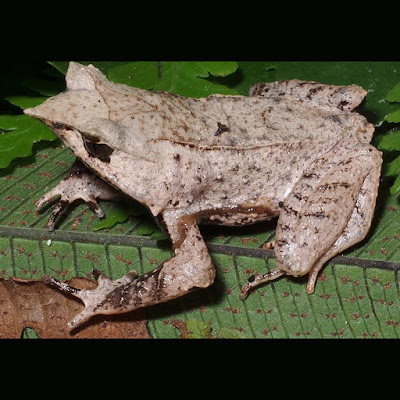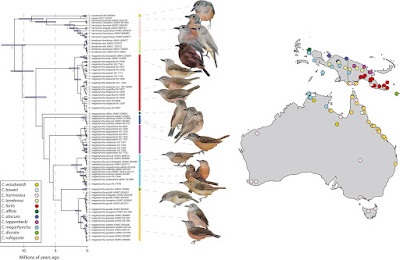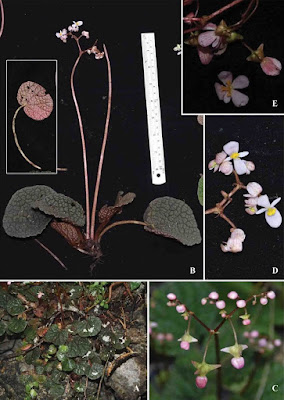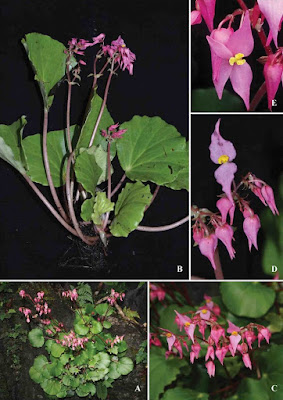[Most Recent Entries] [Calendar View]
Friday, July 13th, 2018
| Time | Event | ||||
| 4:52a | [Herpetology • 2018] Megophrys lancip • A Megophrys Kuhl and Van Hasselt (Amphibia: Megophryidae) from southwestern Sumatra, Indonesia
Abstract Megophrys lancip sp. nov., from the Bukit Barisan mountain range of southwestern Sumatra, Indonesia, is described on the basis of molecular and morphological evidence. The new species is distinguished from its congeners in Sumatra, Java, Borneo, and the Philippines by having a medium-sized body, snout with an extremely pointed rostral appendage, a medium-sized triangular eyelid appendage, a dorsolateral fold extending from just behind the eye to the groin, vomerine teeth, vocal slits, nuptial pads on the dorsomedial surface of the first and second fingers in males, and in lacking a Y, X, or H-shaped fold on the dorsum. Morphologically, the new species is most similar to M. montana, but it has a longer rostral appendage, shorter eyelid appendages, and less developed toe webbing. We also evaluate the taxonomic status of M. parallela and comment on the occurrence of M. aceras in Sumatra. Keywords: Amphibia, Megophrys lancip, new species, Sundaland
Megophrys lancip sp. nov. Etymology. The species name lancip is the Indonesian word for “pointed”, used as an adjective, and reflects the extremely pointed rostral appendage of the new species. Suggested English common name. Pointed Horned Frog. Suggested Indonesian common name. Katak-tanduk lancip. Distribution and Natural History. The new species is known from the provinces of Lampung and Bengkulu in southwestern Sumatra. Larval, acoustic and other ecological data are unknown. The holotype was collected from a coffee plantation near the edge of secondary forest..... This new species of Megophrys can be found sympatrically with M. nasuta in Kubu Prahu, Bukit Barisan Selatan National Park. Habitat loss and exploitation for the pet trade are likely be the main threats for the new species. Misbahul Munir, Amir Hamidy, Achmad Farajallah and Eric N. Smith. 2018. A New Megophrys Kuhl and Van Hasselt (Amphibia: Megophryidae) from southwestern Sumatra, Indonesia. Zootaxa. 4442(3); 389–412. DOI: 10.11646/zootaxa.4442.3.3 | ||||
| 4:53a | [Ornithology • 2018] Molecular Phylogenetics and Species Limits in A Cryptically Coloured Radiation of Australo-Papuan Passerine Birds (Pachycephalidae: Colluricincla)
Highlights: • A time-calibrated molecular phylogeny of all shrikethrushes (Colluricincla). • C. megarhyncha consists of seven unrecognized species. • A new taxonomy for C. megarhyncha is proposed. • C. megarhyncha melanorhyncha belongs in the genus Pachycephala. Abstract Detailed knowledge of species limits is an essential component of the study of biodiversity. Although accurate species delimitation usually requires detailed knowledge of both genetic and phenotypic variation, such variation may be limited or unavailable for some groups. In this study, we reconstruct a molecular phylogeny for all currently recognized species and subspecies of Australasian shrikethrushes (Colluricincla), including the first sequences of the poorly known C. tenebrosa. Using a novel method for species delimitation, the multi-rate Poisson Tree Process (mPTP), in concordance with the phylogenetic data, we estimate species limits in this genetically diverse, but phenotypically subtly differentiated complex of birds. In line with previous studies, we find that one species, the little shrikethrush (C. megarhyncha) is characterized by deep divergences among populations. Delimitation results suggest that these clades represent distinct species and we consequently propose a new classification. Furthermore, our findings suggest that C. megarhyncha melanorhyncha of Biak Island does not belong in this genus, but is nested within the whistlers (Pachycephala) as sister to P. phaionota. This study represents a useful example of species delimitation when phenotypic variation is limited or poorly defined. Keywords: Passerine birds, Corvides, Australia, New Guinea, Cryptic species, Species delimitation Conclusion: In this study, we present a densely sampled molecular phylogeny for the Australasian shrikethrushes. Our results suggest that species diversity within this complex is underestimated, and we consequently propose a revised classification. Nonetheless, we view our proposed taxonomy as preliminary and hope that this study may stimulate further study of species limits in this group. In particular, we believe that increased study of behaviour, contact zone dynamics and vocalizations coupled with the analysis of genome-wide data are likely to be promising in this respect. Petter Z. Marki, Jon Fjeldså, Martin Irestedt and Knud A. Jønsson. 2018. Molecular Phylogenetics and Species Limits in A Cryptically Coloured Radiation of Australo-Papuan Passerine Birds (Pachycephalidae: Colluricincla). Molecular Phylogenetics and Evolution. 124; 100-105. DOI: 10.1016/j.ympev.2018.02.029 | ||||
| 4:55a | [Botany • 2018] Begonia hinnamnoensis & B. khammouanensis • Two New Species of Begonia L. (Begoniaceae) from central Laos
Abstract Two new species of Begonia are described and illustrated from Hin Nam No National Protected Area in the Khammouan Province, Central Laos. Begonia hinnamnoensis Souvann. & Lanors. and Begonia khammouanensis Souvann. & Lamxay, both belonging to Begonia sect. Diploclinium (Lindl.) A. DC. The two new species are endemic to the Khammouan limestone karst. The provisional IUCN status of both new species is here assessed as ‘Vulnerable’. Keyword: Begonia hinnamnoensis, Begonia khammouanensis, Begoniaceae, Limestone flora, Laos, Taxonomy Begonia hinnamnoensis Souvann. & Lanors., sp. nov. ສົ້ມກຸ້ງຄັນຄາກ | Som Koung Khan Khak [Bufo begonia] Sect. Diploclinium. Differs from the allied Begonia gesneriifolia Aver. in having a denser indumentum over all vegetative parts and fruit wings narrowly triangular (B. gesneriifolia has short scurfy hairs, sub-glabrous petioles, glabrous leaf lamina, inflorescenceand flowers, and fruit wings distinctly larger). Also differs from Begonia cladotricha M. Hughes in having a stout rhizome, upper surface of lamina bullate between veins giving a rugose appearance and pistillate flowers smaller fruit wings (B. cladotricha has tuberous rhizome, upper surface of lamina not bullate between veins and pistillate flowers larger fruit wings). − Type: Laos, Khammouan province, Boualapha district, Hin Nam No National Protected Area, ..., 240 m, 9 October 2017, Lamxay et al. HNN 227 (holo HNL, iso FOF, E, SING). Distribution. Endemic to Khammouan province, Boualapha district, Hin Nam No National Protected Area, only know from type locality. Habitat and ecology. Occurring on limestone rock crevices in seasonally dry evergreen forest at 240 m elevation. Flowering September to October; fruiting October to January. Notes. Begonia hinnamnoensis is closely allied with B. cladotricha and B. gesneriifolia, as shown by characters of reniform lamina and pistillate flowers with 5-tepals. The basally-branched hair type of this species is the same as in B. cladotricha (Hughes, 2008b). The specific epithet hinnamnoensis refers to the type locality Begonia khammouanensis Souvann. & Lamxay, sp. nov. ສົ້ມກຸ້ງໃບບົວ | Som Koung Bai Boua [Lotus leaf begonia] Sect. Diploclinium. A distinct species, closest to Begonia crassula Aver. in having succulent leaves, the same number of tepals in male and female flowers and bifid, axile placentae. It differs in being stemless (not succulent caulescent), and in having a symmetric reniform lamina, (not strongly asymmetric and narrowly ovate), and lanceolate and acuminate apex of tepals (not reniform and rounded apex of tepals). − Type: Laos, Khammouan province, Boualapha district, Hin Nam No National Protected Area, ..., 259 m,, 10 October 2017, Lamxay et al. HNN 138 (holo HNL, iso FOF, E, SING). Distribution. Endemic to central Laos; Hin Nam No National Protected Area with three additional populations in Boualapha district, Khammouan province. Habitat and ecology. This species occurs on wet steep rocky slopes in limestone mixed deciduous forest and dry evergreen forest at 230-400 m elevation. Flowering September to October; fruiting October to January. Notes. This species is distinct in its glabrous and glossy symmetrical reniform lamina, and petioles and inflorescences with glandular hairs. The specific epithet khammouanensis refers to the type locality. Keooudone Souvannakhoummane, Soulivanh Lanorsavanh and Vichith Lamxay. 2018. Two New Species of Begonia L. (Begoniaceae) from central Laos. Taiwania. 63(3); 188-194. DOI: 10.6165/tai.2018.63.188 |
| << Previous Day |
2018/07/13 [Calendar] |
Next Day >> |










